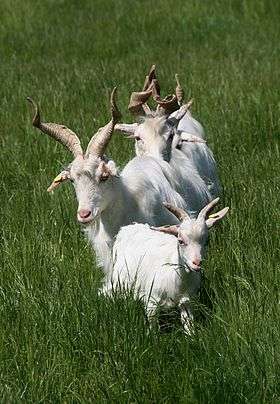Girgentana
 | |
| Conservation status | FAO (2007): endangered[1] |
|---|---|
| Country of origin | Italy |
| Distribution |
|
| Use | milk |
| Traits | |
| Weight | Male: 65 kg[2] |
| Female: 46 kg[2] | |
| Height | Male: 85 cm[2] |
| Female: 80 cm[2] | |
| Wool color | white[2] |
| Face color | white, sometimes yellowish, occasionally grey |
| Horn status | tall spiral horns in both sexes |
|
Goat Capra aegagrus hircus | |
The Girgentana is a breed of domestic goat indigenous to the province of Agrigento, in the southern part of the Mediterranean island of Sicily.[3] The name of the breed derives from Girgenti, the name of Agrigento in local Sicilian language. There were in the past more than 30,000 head in the hills and coastal zone of the province.[2] Today, however, this breed is in danger of disappearance.
History
The origins of the Girgentana breed are unknown.[2] It has been suggested that they are in central South Asia, specifically Kashmir, northern Afghanistan, and Balochistan. Johann Wolfgang Amschler identified it with Capra prisca and the Ram in a Thicket statues excavated at Ur by Leonard Woolley in 1927–28. The hypothesis of Leopold Adametz that it is descended, at least in part, from the markhor, Capra falconeri, a species of Central Asian goat-antelope, appears to be generally accepted by zoologists.[2] The animals could have been introduced to Sicily by Greek colonists about 700 BC, or in the eighth century AD by Arab invaders.[2]
The Girgentana is one of the eight autochthonous Italian goat breeds for which a genealogical herdbook is kept by the Associazione Nazionale della Pastorizia, the Italian national association of sheep-breeders.[4][5] It was formerly numerous in the province of Agrigento, where there were more than 30,000 in the coastal area and the hilly hinterland. It has since fallen rapidly, to the point that measures for its protection may be needed. At the end of 1993 the population was estimated at 524. The conservation status of the breed was listed as "endangered" by the FAO in 2007.[1] At the end of 2013 the registered population was 390.[6]
Characteristics
The Girgentana goat has characteristic horns, twisted into a spiral form. It has a long beard and a primarily white coat with grey-brown hair around the head and throat. It has a good production of high-quality milk.
References
- 1 2 Barbara Rischkowsky, D. Pilling (eds.) (2007). List of breeds documented in the Global Databank for Animal Genetic Resources, annex to The State of the World’s Animal Genetic Resources for Food and Agriculture. Rome: Food and Agriculture Organization of the United Nations. ISBN 9789251057629. Accessed May 2014.
- 1 2 3 4 5 6 7 8 9 Daniele Bigi, Alessio Zanon (2008). Atlante delle razze autoctone: Bovini, equini, ovicaprini, suini allevati in Italia (in Italian). Milan: Edagricole. ISBN 9788850652594. p. 362–63.
- ↑ Breed data sheet: Girgentana / Italy. Domestic Animal Diversity Information System of the Food and Agriculture Organization of the United Nations. Accessed May 2014.
- ↑ Le razze ovine e caprine in Italia (in Italian). Associazione Nazionale della Pastorizia: Ufficio centrale libri genealogici e registri anagrafici razze ovine e caprine. p. 19. Accessed May 2014.
- ↑ Strutture Zootecniche (Dec. 2009/712/CE - Allegato 2 - Capitolo 2) (in Italian). Ministero delle Politiche Agricole Alimentari e Forestali. Section I (e). Archived 4 December 2013.
- ↑ Consistenze Provinciali della Razza 42 Girgentana Anno 2013 (in Italian). Associazione Nazionale della Pastorizia: Banca dati. Accessed May 2014.
Further reading
- A. Magliano (1930). La capra girgentana. L'Italia agricola. Piacenza. p. 481–498
- Agraria.org (in Italian)
- Assonapa.com (in Italian)
- Associazione Italiana Allevatori e Produttori della Capra Girgentana (in Italian Language)